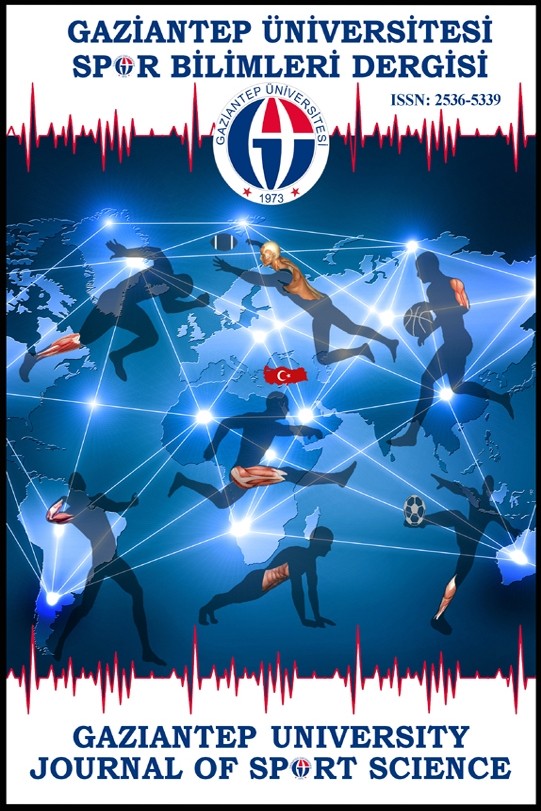Elit Genç Futbolcularda Küçük Alan Oyun Antrenmanın Hoff Test Skorlarına Etkisi
Bu araştırmanın amacı, küçük alan oyun (KAO) antrenmanlarının elit genç futbolcularda Hoff test skorlarına olan etkisini araştırmaktır. Araştırmaya, sağlıklı ve gönüllü 21 antrenmanlı elit genç erkek futbolcu katıldı. KAO antrenman programları, haftada 3 gün (Pazartesi, Çarşamba ve Cuma) olmak üzere 4 hafta süresince (toplam 12 antrenman) uygulandı. Ayrıca katılımcılara KAO öncesi ve sonrası futbola özgü Hoff testi uygulandı. Çalışma öncesi katılımcıların yaş, boy, ağırlık ve beden kütle indeksi değerleri alındı. Katılımcıların koşu mesafesi, kalp atım hızı ve yüklenme şiddeti değerleri ise KAO ve Hoff testlerinden elde edildi. İlk ve son test ortalamaları arasındaki varyanslar Tek Yönlü ANOVA testi ile belirlendi. Elde edilen değişkenler arasındaki doğrusal ilişkiler ise Pearson Korelasyon Katsayısı ile belirlendi. Testlerde P<0.05 düzeyi anlamlı olarak kabul edildi. Araştırma grubunun ön ve son test tüm değişkenleri arasında anlamlı düzeyde bir gelişme olduğu gözlendi (p<0.05). Değişkenler arasındaki ilişkilerde ise, pozitif veya negatif yönlü orta ve çok yüksek düzey arasında ilişkilerin olduğu gözlenmiştir (p<0.01). Elit genç futbolcuların koşu mesafesi, kalp atım hızı ve yüklenme şiddetlerindeki gelişmeler nedeniyle kapasitelerinin de arttığı sonucuna varıldı. Ayrıca futbola özgü hareketleri içeren Hoff test değerleri, elit genç futbolcuların kapasitelerini belirlemede ve antrenman programlarını hazırlamada antrenörlere yardımcı olabilir.
The effect of small-sided game training on Hoff test scores in elite young soccer players
The aim of this study was to investigate the effect of small-sided game (SSG) training on Hoff test scores in elite young soccer players. This study included 21 healthy and voluntary young male soccer players. SSG training programs were administered for 4 weeks (total 12 training sessions), and 3 days a week (Monday, Wednesday and Friday). In addition, the participants were taken in soccer-specific Hoff test before and after SSG. Age, height, weight and body mass index values of the participants were taken before the study. Running distance, heart rate and loading intensity values were obtained from SSG and Hoff tests. One-way ANOVA test was used to determine the variances between the first and last test means. The linear relations between the obtained variables were determined by Pearson Correlation Coefficient. P<0.05 was considered significant in the tests. There was a significant improvement between the pre- and post-test variables of the study group (p<0.05). In the relations between the variables, it was observed that there was a relationship between medium and very high level in positive or negative direction (p<0.01). It was concluded that the capacity of elite young players increased due to improvements of running distance, heart rate and loading intensity. Also, the Hoff test values, which include soccer-specific movements, can help coaches in determining the capacity of elite young players and preparing their training programs.
___
- Bennett, K.J.M., Novak, A.R., Pluss, M.A., Stevens, C.J., Coutts, A.J., Fransen, J., (2018). The use of small-sided games to assess skill proficiency in youth soccer players: a talent identification tool, Science and Medicine in Football, 2 (3): 231-236.
- Brouwer, A.M., Van Dam, E., Van Erp, J.B.F., Spangler, D.P., Brooks, J.R., (2018). Improving real-life estimates of emotion based on heart rate: a perspective on taking metabolic heart rate into account. Front Hum Neurosci, 12: 284.
- Hoff, J., Wisløff, U., Engen, L.C., Kemi, O.J., Helgerud, J., (2002). Soccer specific aerobic endurance training. Br J Sports Med, 36: 218-221.
